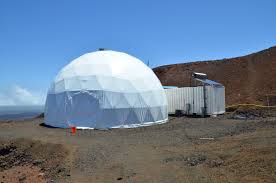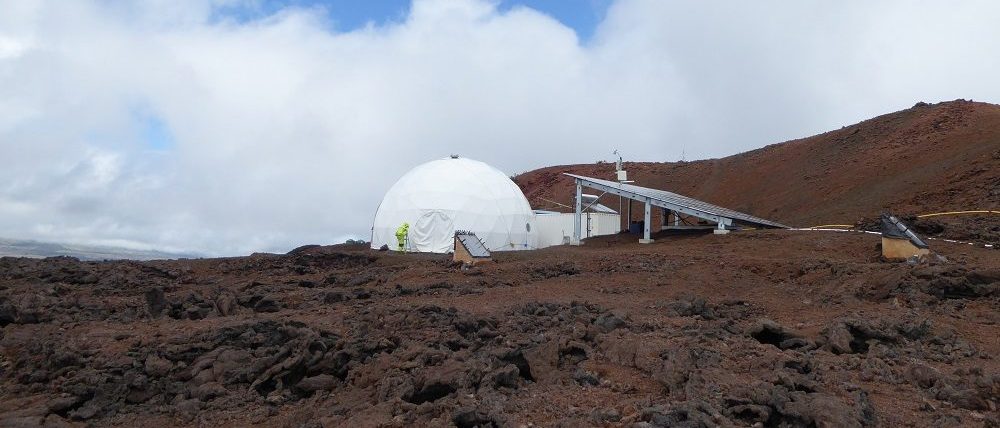Six people from different countries and careers, are headed to Mars by way of Mona Loa, Hawaii. This is simulated space. For 12 months, it will be our home.
 Simulated space is both just like it sounds, and nothing like it seems. When people think of space, it’s largely echoes of movies: Gravity, Apollo 11, or even documentaries like Time’s A Year In Space. These simulate space as well, with microgravity, great views and the possibility of death by fire, lack of oxygen and decompression. What space – both real and simulated – is more like is what Scott Kelly describes in Episode 1 of A Year In Space. It’s complete lack of weather.
Simulated space is both just like it sounds, and nothing like it seems. When people think of space, it’s largely echoes of movies: Gravity, Apollo 11, or even documentaries like Time’s A Year In Space. These simulate space as well, with microgravity, great views and the possibility of death by fire, lack of oxygen and decompression. What space – both real and simulated – is more like is what Scott Kelly describes in Episode 1 of A Year In Space. It’s complete lack of weather.
I don’t mean to imply that there won’t be weather on Mona Loa, where our habitat is location, or on Mars, where we hope to relocate to someday. There’s weather on both, of course. What I mean is regulation and sensory deprivation. The regulated nature of these missions keeps chaos at a minimum . The regulation comes from a few forces, all of which act at the same time. There’s mission control, which asks us to do and not do things, as needed (or wanted. It’s not always clear. More on this later). There’s the needs of your crew. They need you to be up by a certain time, making breakfast, suiting up, helping someone else suit up. Then there’s the demands of the mission itself. We need to check on the solar panels, to watch our energy and water use, to plan our days so that there’s enough food, sleep, exercise and science. Very few things are allowed to just happen. In space, that can be dangerous, as well as a waste of time and precious resources. So, everything is plotted, planned, and scheduled.
As for the sensory depravation, there will be some of that on SMARS (simulated Mars). We’ll have white walls, a white ceiling and no phone calls. There’s no internet (more on that later), though I’m told that a former crewperson downloaded all of Wikipedia and brought it into the dome on a harddrive. Unlike HERA, a simulated mission to an asteroid that two of us went on in April, there will be sun and sky. In terms of staving off sensory depravation, these are a good things. HERA has only viewscreens showing space, though sometimes the Earth, Moon or our destination asteroid popped into view. After only 14 days of a viewscreen-only window to the world, myself and my fellow crewman screamed out loud when we stepped outside and saw the sun. The nuclear fireball in the sky had thousands of megatons of radioactive PAIN lying in wait for us, which, somehow, we had never noticed before.
That’s the key right there. Before HERA, we were used to the Sun. And phone calls; medical bills; the sound of car breaks. After a short dose of simulated space, we were no longer equipped to handle any of it. One of my colleagues was nearly run into while trying to circumnavigate a grocery store parking lot. This can happen to anyone, but it happened to him because he didn’t expect the cars to be there. After HERA, we all had a bit of a time dealing with the fact that people wanted to call us. In truth, we had some trouble with that even during the HERA itself. Because our mission simulated a trip to a Mars-crossing asteroid, when we got “far enough” from Earth, we had communications delays. At first, it was 5 minutes each way. Then, it was 10 minutes.
After we explored Geographos and headed home, those comm delays shrank. That wasn’t entirely welcome news. We had become accustomed to doing things on our own. Not that we resented Mission Control – we needed them as much as ever for logistics and information – we just didn’t need them to give us permission to stop and go, sleep and wake up, build the robots or plant the seeds. During the communications delay, we had figured out how to handle that all on our own. In other words, by that time we were real grown astronauts, and preferred to be treated as such. Every beep and squawk out of the radio meant that someone, somewhere might be getting ready to treat us like kids again.
In HERA, it was just the 4 of us, plus ground support, for two week. In HI SEAS, it will be the six of us, a constant 20 minute delay to mission control, and whatever we bring with us for amusement. Music, movies. Russian lessons – though with native French and German speakers, and my LA Spanish, we could end up very cunning linguists before this is all over. Several of us have promised/threatened to teach the rest how to dance. All of us will cook. We’ll cook our faces off, because, if it’s one thing all humans love, we LOVE to eat. I’ve been given the green light to culture food, from bread to tempeh, yogurt to kambucha. We’ll be growing food, too, as much as we can given the light we have and the light we can generate (one of the previous crews used LEDs).
In this blog, I’ll be asking for advice from people who love to cook, who have cultured food, grown food indoors, composted, learned a languages. Your advice is appreciated. There’s only 6 us, and 6 billion of you. We may be the Martians, but collectively, and sometimes individually, you know much more than we do about just about everything – except, perhaps, what it’s like to be a Martian. That part, we’ll tell you all about here. Stay tuned. Copyright secured by Digiprove © 2017
Copyright secured by Digiprove © 2017
